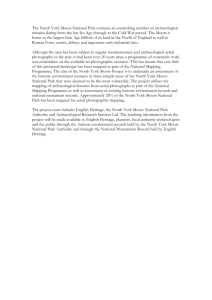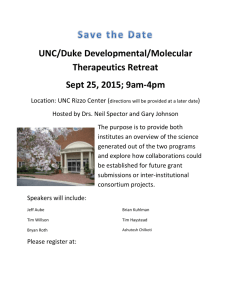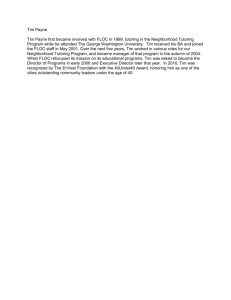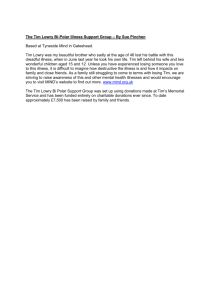Network Management Systems
advertisement
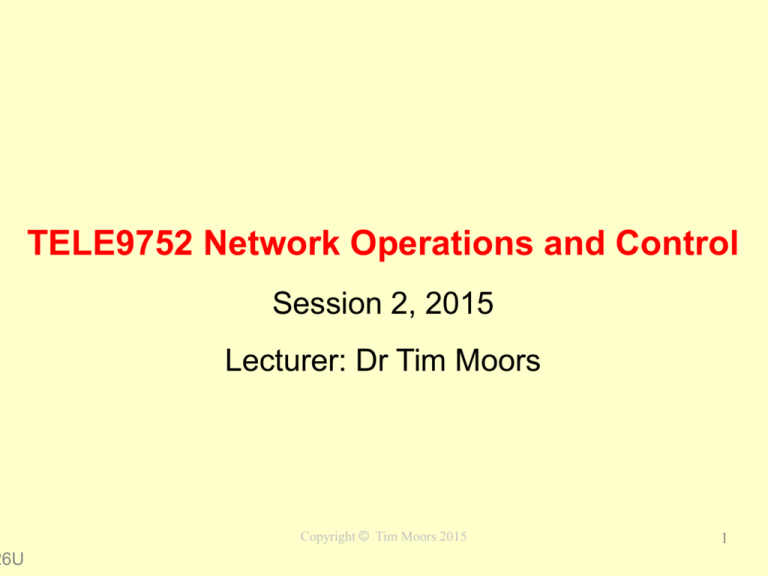
26U TELE9752 Network Operations and Control Session 2, 2015 Lecturer: Dr Tim Moors Copyright © Tim Moors 2015 1 2MH Agenda Intro. to Network Operations and Control Course administrivia Enough for now: Slides are available on the course web page http://subjects.ee.unsw.edu.au/tele9752 Slide IDs in bottom-left corner used in references Tim tries to not talk too fast Participate: Ask & answer questions Bonus marks in Copyright lectures… [NZ> © Tim Moors 2015 2 2NZ Bonus marks in lectures Hard for lecturer to remember who made what comment during lecture => Issue cards to people who participate well in lecture. Blue = good, Green = better See Lecturer during breaks in lecture to record last 3 digits of your student ID, e.g. z1234567 3 Copyright © Tim Moors 2015 Image from http://eyad-arqoub.com/red-card-lifting-in-my-face/ 2FJ Outline • NOC core images • What is being managed • Dividing the task (FCAPS, OAM&P) & division of labour • Miscellany Copyright © Tim Moors 2013 4 Network Operations Centre glamour Copyright © Tim Moors 2015 Image from http://www.research.att.com/areas/visualization/projects_software/photo_global_center.jpg 2QAOthers at http://royal.pingdom.com/?p=296 NOC aka “Network Operations Center” 5 Other operations & control centres NSW NASA's Roads & Traffic Authority Johnson Space Center's (JSC) Australian Dept. of Defence “Transport Management Centre” Mission Control Center (MCC) Network Operations Centre 2W8 Figures from http://www.rta.nsw.gov.au/trafficinformation/downloads/tmcbrochure.pdf Copyright © Tim Moors 2015 http://www.nasa.gov/audience/formedia/presskits/ffs_gallery_mcc_image1.html http://www.defence.gov.au/defencemagazine/editions/200610/groups/cio.htm 6 Network Operations norm Cubicle farm + Colocation centre (“colo”) Images from http://flickr.com/photos/kgibbons/953060828/ and http://flickr.com/photos/malffred/2517584165/ 2CA Copyright Copyright©©Tim Tim Moors Moors 29/07/08 2015 7 See also http://arstechnica.com/business/2012/03/super-secret-google-builds-servers-in-the-dark/ Google Throws Open Doors to Its Top-Secret Data Center and Streetview 2V7 NOC vs NM Typically NOC = Network Operations Center NM = Network Management what is done at/from a NOC so named in most written material, e.g. text books Management can get very broad and fuzzy, very fast. This course focuses on management of technology, not management of people => “Network Operations and Control” This lecture outlines the broader context, including business/personnel aspects of NM Copyright © Tim Moors 2015 8 Outline Copyright © Tim Moors 2015 What should we operate & control? Definitely: • Network devices: links, routers/switches • Network-centric services: DHCP, DNS, firewalls, authentication, NAT, caches Probably: • Servers accessed through network: web, file servers, etc Arguably: • Protocols on end-systems (e.g. TCP)? • All IT systems?! Copyright © Tim Moors 2015 21L Figure from Kurose & Ross 10 27D NM entities 1 Network element: Parts of the network that can be separately managed i.e. hardware devices (e.g. routers) and modules (e.g. interface card) and software processes (e.g. Apache) Not all network devices are manageable, e.g. wiring closet, dumb switch. Managed object [UR>: A representation of an aspect of an element that can be managed e.g. IP address & default TTL, count of packets received MIB (Management Information Base) – a collection of related objects, e.g. IP-MIB of objects relating to implementations of the Internet Protocol Copyright © Tim Moors 2015 11 2F3 NM entities 2 Management agent: Software on element that enables management Implements protocols such as the Simple Network Management Protocol (SNMP) Network Management System/centre (NMS/NMC): Manages objects through agents; often based in a NOC May offer the Manager a Command Line Interface (CLI) (e.g. [WJ>) or Graphical User Interface (GUI) Manager/Mgr: a person; manages the network, not (necessarily) other people, aka “network administrator” Copyright © Tim Moors 2015 about. 12 Services: What users directly care Rising levels of abstraction ITU's Telecommunications Management Network (TMN) model defines several Management Layers [M.3010]: Business ML: Manage workflow & monetary aspects Service ML: Manage all elements to provide a desired service, e.g. VOIP for some user Network ML: Manage a group of elements; e.g. address numbering plan r Element ML: Manage individual elements Network element: Provides the service, e.g. router, link, web server process Figure from [Clemm] “Network Management” here == managing the network rather than elements != NM elsewhere e.g. <V7] For a tutorial on TMN, see http://www.simpleweb.org/tutorials/tmn/index.html Copyright © Tim Moors 2015 13 Note that the “Element Management” layer involves managing individual elements, whereas “Element 2XTManagement Systems” [http://www.iec.org/online/tutorials/ems/] involve managing multiple elements. 2!!!! Management interfaces Element management: Direct (manager to element) Command Line Interface Web interface – hosted on the device Indirect: (via protocols) e.g. SNMP, syslog Network management: NMS; Nagios & MRTG Configuration databases Service management: Operations Support Systems Copyright © Tim Moors 2015 Trouble ticket systems [JW> 14 Outline Copyright © Tim Moors 2015 2QP NM vs network tech courses Network technologies courses (e.g. TELE3118) describe how networks work to deliver payload for users. What happens when things go wrong? Faults (F) Assumes network already exists - how was it planned, installed, configured for local conditions? (C) Who pays/paid for it? Accounting (A) Need to monitor performance, e.g. to inform planning, detect faults, etc? Performance (P) How is it secured (e.g. against fraud)? How is security configured? Monitoring to detect security events? (S) => (F)(C)(A)(P)(S) Copyright © Tim Moors 2015 16 Management Functional Areas The CCITT (now ITU) defined 5 “functional areas” for managing OSI systems: “FCAPS” [X.700]: Fault management: Detect, isolate and correct abnormal operation Configuration management: Set parameters that govern behaviour Accounting management: Enable charging for resource use Performance management: Measure and record system behaviour Security management: “support the application of security policies” OSI = Open Systems Interconnection = alternative to TCP/IP model from 1980s Copyright © Tim Moors 2015 22W Comer cites M.3400 as the source, but that refers to X.700 17 26A OAM&P FCAPS covers most tasks, but organisational substructures (needed for larger telcos) tend to differ OAM&P is often used (but scantily defined†): Operations: Monitoring and detecting faults (F) Administration: Monitoring traffic for billing (A) & capacity planning (P) Maintenance: Installation, configuration(C) & fixing faults(F) Provisioning: Planning & design (based on P), set up service for new users (C,S) Copyright © Tim Moors 2015 † See RFC 6291: Guidelines for the Use of the "OAM" Acronym in the IETF 18 2TX Multiple managers Multiple managers support: • specialisation in different areas, e.g. web vs fibre • 24x7 need for network management(vs “40hour” work week) • volume of work • particular customer groups, e.g. local service may be quicker to arrive or take responsibility for customer UNSW => Managers may vary in their access EE&T to objects. Restrict access with “views”[73> Copyright © Tim Moors 2015 read/ write CSE read 19 Tiered technical support Managers often form a hierarchy with stronger skills at higher levels. Level 0/1 faces customers: lowest skill: cheaply deal with common cases Requests/incidents needing extra skill “escalate” to a higher level. Figure from “SYMIAN: Analysis and Performance Improvement of the IT Incident Management Process” 20 Copyright © Tim “higher” = “further to right” in this figure. Think of itMoors rotated2015 anticlockwise by 90 degrees. 2JW Operations Support Systems (OSS) = Systems (often software) to automate and coordinate network operation tasks Covers higher levels of TMN model (service & business management) as much (if not more) than NM. The TeleManagement Forum (TMF) is developing a “New Generation Operations Systems and Software” (NGOSS) Local OSS developers: www.clarity.com & previously fastwire-group.com & elantisystems.com For a (somewhat dated) tutorial on OSS, see http://www.iec.org/online/tutorials/oss/ Copyright Tim Moors 2015 Business Support Systems (BSS) focus on © customers, e.g. accepting orders, sending bills21 24A & receiving payments. Outline Copyright © Tim Moors 2015 2J1 Lifecycle of network management "Intuitively, network management encompasses tasks associated with planning, deploying, configuring, operating, monitoring, tuning, repairing, and changing computer networks." - D. Comer, p. 26 i.e. like “NM vs network tech courses” slide <QP]: NM = everything needed other than the running network. Figure from Clemm p. 116 Copyright © Tim Moors 2015 23 2XM NM = the manual stuff? “network management is best described as all the aspects of devising and operating a network that no one knows how to automate.” - in D. Comer: Automated Network Management Systems, p. 26 NM usually involves human intervention But technology can improve human productivity e.g. DHCP, SNMP, root cause analysis software... Copyright © Tim Moors 2015 24 2TW Man vs machine Automated systems: Don't introduce human errors (at least during operation, if not during design) Respond faster Reduce labour costs But may not be customised for local conditions can be complex/difficult to understand (e.g. disable STP) may hide useful info (e.g. network becoming brittle and about to partition) may not match human judgement Copyright © Tim Moors 2015 25 23W Why NM/NOC is challenging Complex: Communication networks are complicated and change rapidly. Information hidden to ease design may be needed for debugging. Distributed systems are hard to control: unsynchronised and inconsistent state. Fault management systems must work when the rest of the network doesn't. Internet pushes functionality to ends, away from NM reach collection of Autonomous Systems => heterogeneous & many responsible parties Vendor competition:Copyright Users it, vendors don't © Timwant Moors 2015 26 2L8 network + “management” but not NM Any issue can be “managed”, but NM doesn't cover all network issues, e.g. Power management, e.g. mobile device use of WiFi Link Management Protocol [RFC 4204] - part of GMPLS/Bluetooth Active Queue Management [TELE9751] Mobility management and location management Internet Group Management Protocol Traffic management Key management (e.g. ISAKMP) Copyright © Tim Moors 2015 27 2R2 Network Management standards OSI Common Management Information Services & Protocol IETF X.700: FCAPS for OSI management M.3000: Telecommunications Management Network Distributed Management Task Force (dmtf.org) SNMP, syslog, IPFIX etc [RFC 6632] ITU Same issues & fate as OSI Reference Model Manage distributed computing systems Copyright Tim Moors 2015 28 Others: TMF(NGOSS), tech© bodies: IEEE, Broadband Forum... History of Network Management Originally: Network designers = operators + small networks => manual NM 1970s: phone companies develop OSS, CCITT X.700 1980s: Data networks appear 1990s: Heterogeneous networks OSI CMIP vs IETF SNMP Cisco IOS vendor-neutral NMS, e.g. HPOV & IBM Tivoli 21st century: open source software (e.g. openNMS, Nagios) Software Defined Networking Copyright © Tim Moors 2015 2UK HPOV = Hewlett Packard OpenView 29 20R Agenda Intro. to Network Operations and Control Course administrivia Copyright © Tim Moors 2015 30 2UQ Ad break Want to do a thesis/project on networking, e.g. as part of MEngSc(Ext) or ME degree? Several in the broad areas of “video communication”, “network reliability” and “software defined networking” See http://www2.eet.unsw.edu.au/~timm/thesis.html You must have done well in networking course(s), possibly have industrial experience & be confident programming Email resume and academic records to t.moors AT unsw.edu.au ASAP (definitely by end of week 1) Copyright © Tim Moors 2015 31 2M6 Administrivia Aims Assessment Copyright © Tim Moors 2015 32 2L9 The aim of this course The aim of TELE9752 is to develop student understanding of how telecommunication networks are operated and controlled. That is, whereas other networking courses focus solely on the technologies that enable users to transfer information across a network (e.g. TELE3118 focuses on network protocols, and TELE9751 focuses on the design of network equipment), this course considers how such technologies can be operated and controlled by people concerned with service provision (e.g.Copyright network administrators). © Tim Moors 2015 33 Test next week This course assumes prior knowledge of an introductory networking course like UNSW's TELE3118. Entry to Masters programs is often through completion of a “related” BE degree. => Students often struggle due to inadequate background But this can be fixed: 1. Multiple choice test in week 2 to assess your background. Bring pencil & eraser. 2. Quick feedback 3. Online resources 4. No class in week 3 gives you time to strengthen background Copyright © Tim Moors 2015 2C0 Assessment 90% Exams 0% background diagnostic test 40% mid-session exam 50% final exam 10% Group research [HN> + 10% Bonus marks for course improvement/participation Unfortunately no practical exercise this year due to equipment issues. Copyright © Tim Moors 2015 35 2HN Group research Aims: information literacy: Accessing latest NOC advances experience collaboration develop communication skills exposure to content: 1 aspect in depth + intro to several aspects 3 hours @ 12min/pres + 3min? + 2 x 12min breaks = 54+ students / 8 papers => groups of about 7 (Might ↑ members to ↓ groups to ↑ time/paper.) Groups to be allocated in week 3, after enrolments stabilise. Product (not process) will be assessed => specialise according to skills/interests. Teamwork review around week 9 Copyright © Tim Moors 2015 36 How assessment relates to course aims 2DJ The bulk (70%) of assessment (exams) consists of individual tasks, ensuring that it assesses the extent of your learning. tests “in-depth engagement with the relevant disciplinary knowledge” Exercise to assess practical application of knowledge Group research to develop information literacy and collaborative & communication skills Copyright © Tim Moors 2015 37 2YT Continual course improvement Solicitation of suggestions Add comments to the “Suggestions for improving the course” Moodle forum in person You can receive bonus marks for constructive suggestions! Action on past suggestions Tim trying to talk slower. May record audio for final slides in lecture if run out of time during class. Copyright © Tim Moors 2015 38 24L Textbooks Still searching for a highly recommended text! Recommended: A. Clemm: Network Management Fundamentals, Cisco Press Many others in the library References in slides may reflect convenience rather than quality. Copyright © Tim Moors 2015 39 2!!!! Things to think about • Critical thinking: If FCAPS & OAM&P are 2 ways to divide the tasks, might there be other (better) ways? • Engineering methods: • • Tiered support <JW] is an example of minimising costs by using the cheapest solution possible for each task. The NM lifecycle <J1] is like that of other engineered systems. • Links to other areas: • • Management centres for transportation, space etc systems FCAPS equivalents in other engineering fields • Independent learning: • “Network Management Challenges and Trends in MultiLayer and Multi-Vendor Settings for Carrier-Grade Networks” surveys current (2014) issues Copyright © Tim Moors 2015 The end Ad: Supervision available for projects listed at http://www2.eet.unsw.edu.au/~timm/thesis.html Copyright © Tim Moors 2015 41 2PV Outline of NOC intro slides Numbers & identifiers identify slides which cover each topic Imagery of NOC core 4 QA glamour 5 W8 Control centres in other fields 6 CA reality Context 5 W8 Control centres in other fields 8 V7 NOC vs NM 13 QP NM vs network tech courses 23 L8 network + “management” but not NM 12 0Q Business aspects of NOC What is involved 7 1L What should we operate & control? 9 7D NM entities 1 10 F3 2 18 4A Operations Support Systems (OSS) 20 XM NM = the manual stuff? 21 TW Man vs machine Misc 22 3W Why NM/NOC is challenging 24 R2 Network Management standards 25 UK History of Network Management Ways of dividing the problem 11 XT Rising levels of abstraction 14 2W Management Functional Areas 15 6A OAM&P 16 TX Multiple managers 17 JW Tiered technical support 19 J1 Lifecycle of network management 42

